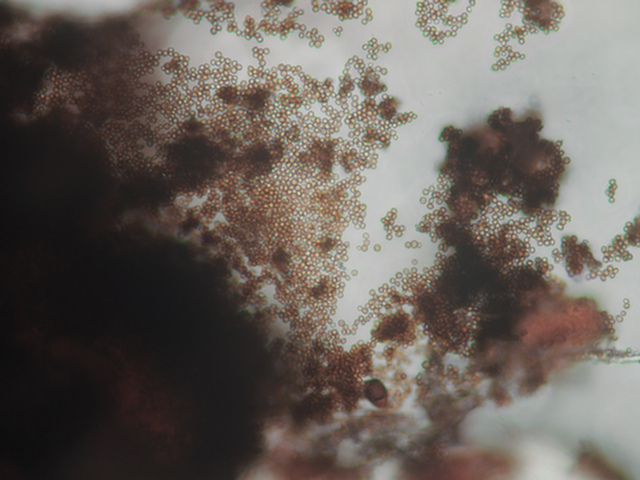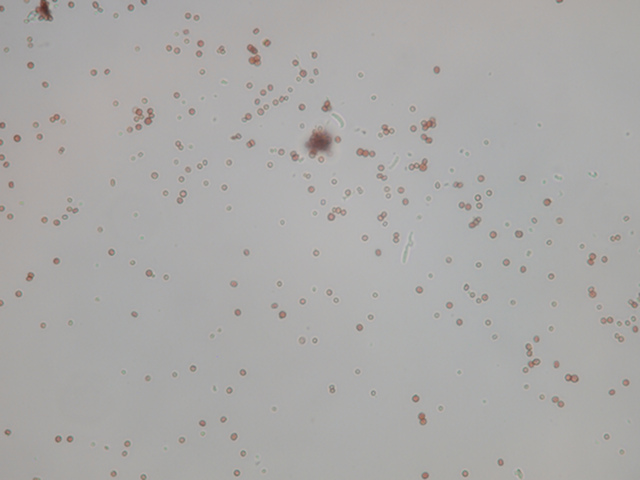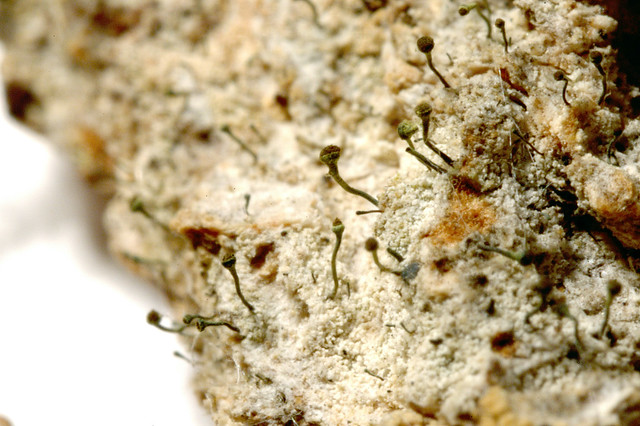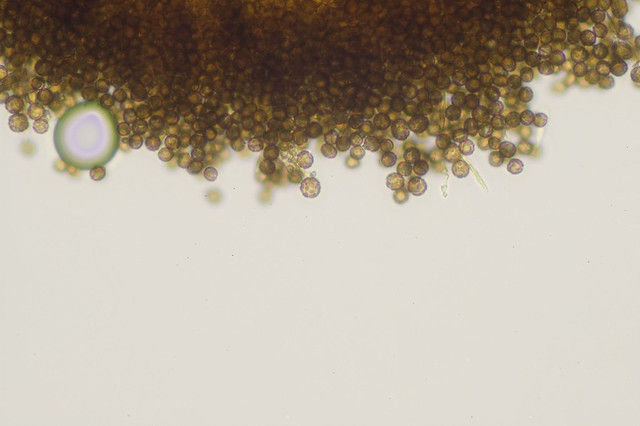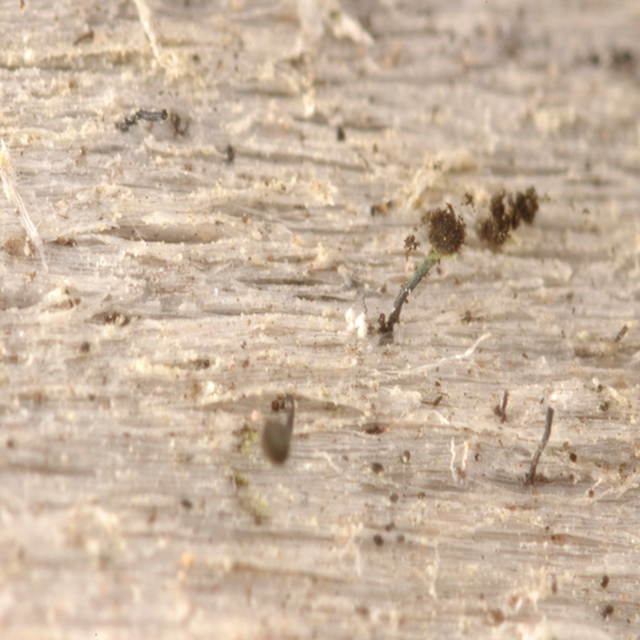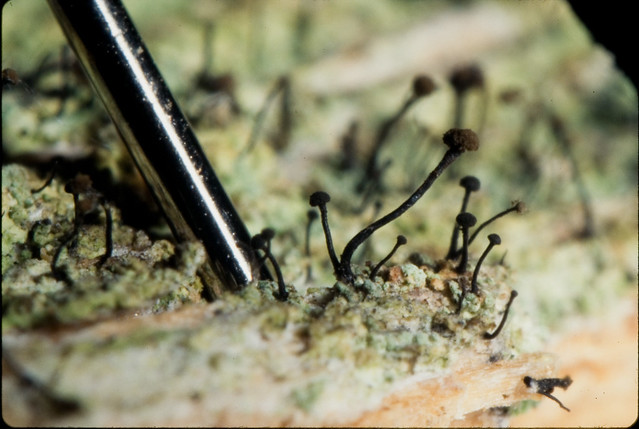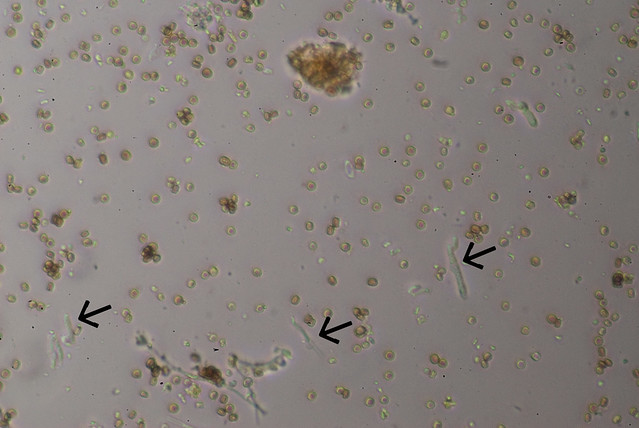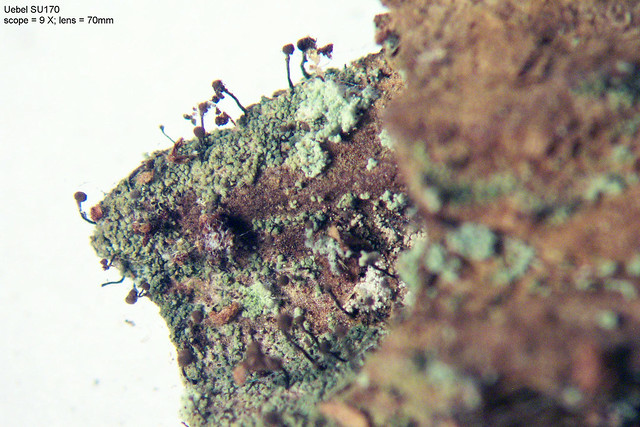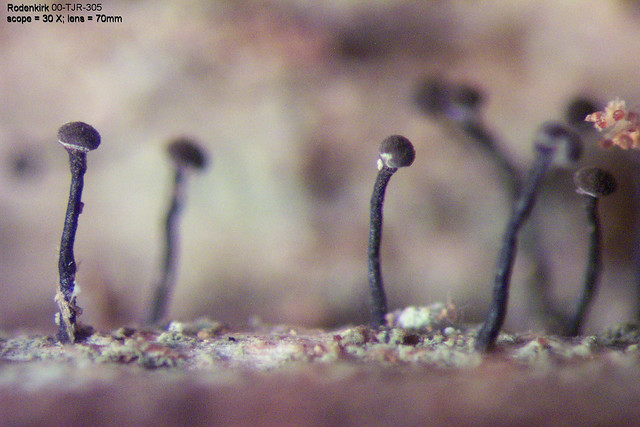Xataface
Crustose.net HOME
Top
- HOME
- Introduction
- History of "Caliciales" and the Origin of the "Calicioids"
- Biogeography of Calicioids
- Calicioid Ecology and Habitats
- Conservation
- Zen and the Search for Calicioids
- Collecting and Curating
- Key to Genera
- Acolium
- Acroscyphus
- Allocalicium
- Bruceomyces
- Calicium
- Chaenotheca
- Chaenothecopsis
- Cyphelium
- Cryptocalicium
- Microcalicium
- Mycocalicium
- Phaeocalicium
- Pseudothelomma
- Sclerophora
- Sphinctrina
- Stenocybe
- Texosporium
- Thelomma
- Tholurna
- "Within-bark"
- Glossary
- References
0.01 (development)
Eric B. Peterson
Chaenotheca
The genus Chaenotheca can be roughly generalized as lichenized calicioids with brown spore masses. The darkness of the spore mass can vary from pale brown to nearly black, but the vast majority are medium to moderately dark brown. The genus makes use of several different photobionts (algae), therefore a key to photobionts is provided first.
Taxa covered (32):
Chaenotheca australis
Chaenotheca balsamconensis
Chaenotheca biesboschii
Chaenotheca brachypoda
Chaenotheca brunneola
Chaenotheca chlorella
Chaenotheca chloroxantha
Chaenotheca chrysocephala
Chaenotheca cinerea
Chaenotheca citriocephala
Chaenotheca confusa
Chaenotheca deludens
Chaenotheca ferruginea
Chaenotheca floridana
Chaenotheca furfuracea
Chaenotheca gracilenta
Chaenotheca gracillima
Chaenotheca hispidula
Chaenotheca hygrophila
Chaenotheca laevigata
Chaenotheca longispora
Chaenotheca nitidula
Chaenotheca olivaceorufa
Chaenotheca papuensis
Chaenotheca phaeocephala
Chaenotheca servitii
Chaenotheca sp. nov. 1
Chaenotheca sphaerocephala
Chaenotheca stemonea
Chaenotheca subroscida
Chaenotheca trichialis
Chaenotheca xyloxena
Chaenotheca balsamconensis
Chaenotheca biesboschii
Chaenotheca brachypoda
Chaenotheca brunneola
Chaenotheca chlorella
Chaenotheca chloroxantha
Chaenotheca chrysocephala
Chaenotheca cinerea
Chaenotheca citriocephala
Chaenotheca confusa
Chaenotheca deludens
Chaenotheca ferruginea
Chaenotheca floridana
Chaenotheca furfuracea
Chaenotheca gracilenta
Chaenotheca gracillima
Chaenotheca hispidula
Chaenotheca hygrophila
Chaenotheca laevigata
Chaenotheca longispora
Chaenotheca nitidula
Chaenotheca olivaceorufa
Chaenotheca papuensis
Chaenotheca phaeocephala
Chaenotheca servitii
Chaenotheca sp. nov. 1
Chaenotheca sphaerocephala
Chaenotheca stemonea
Chaenotheca subroscida
Chaenotheca trichialis
Chaenotheca xyloxena
Species in contemporary literature yet to be addressed: Chaenotheca benearnensis (Mycobank Record)
Key to Photobionts associated with Chaenotheca spp.
- 1a. Cells small, elongate (like beans, or short sausages), clustered or in chains, internal structure generally not visible.Stichococcus
-
- 2a. Cells with carotinoid pigments occasionally to commonly visible, most notably > 10μm diameter and with a thick wall (do not confuse with a coating of hyphae).Trentepohlia
- 2b. Cells always entirely green or transparent (sometimes with a single amber colored body, possibly the pyrenoid), variable in size and Wall thickness...(Chlorococcales).
- 3a. Cells generally greater than 10μm diameter.Dictyochloropsis
- 3b. Cells generally less than 10μm diameter.Chlorococcales (usually Trebouxia)
Key to Species of Chaenotheca
Validation script believes all taxa are included in the key(s).
-
- 2a. Mature ascospores ellipsoidal (length to diam. ratio >1.25), a small portion of spherical ascospores may be present.
- 3a. Thallus intensely yellow; thallus granular; ascospore length 5.0 - 10.0 μm.Chaenotheca chrysocephala
- 3b. Thallus not intensely yellow; thallus granular, farinose, or immersed; ascospore length 4.0 - 18.6 μm.
- 4a. Photobiont Trentepohlia (cells >10 μm with cell walls irregularly thickened >2 μm); thallus immersed; spores smooth, elipsoidal, 5.5 - 7μm long.Chaenotheca citriocephala
-
- 5a. Photobiont Stichococcus (cells ellipsoidal; internal structure usually indistinct); thallus generally well developed, verrucose, greenish gray to green; ascospore length 4.0 - 8.0 μm.Chaenotheca chlorella
- 5b. Photobiont trebouxioid (cells spherical; internal structure usually distinct); thallus immersed or well developed, grayish green to yellowish gray; ascospore length 5.5 - 18.6 μm.
- 6a. Thallus immersed or superficial, olivaceous or grayish green, PD - , K - ; ascospores with rough ornamentation, sometimes septate, length variable within an ascomata 5.0 - 10.0 ( - 15.0) μm.Chaenotheca laevigata
- 6b. Thallus well developed, granular to farinose, greenish gray or yellowish gray, PD+ orange, K+ yellow; ascospores spirally ornamented, typically multi-septate, length 12.1 - 18.6 ( - 25.0) μm.Chaenotheca longispora
-
-
- 8a. Spore-mass pale beige, yellow, or white.See Sclerophora
-
- 9a. Mature spores 5.0-7.6 μm diameter, irregularly fissured, reddish brown in color.Chaenotheca hispidula
- 9b. Mature spores 2.9-3.5 μm diameter. Spore mass tending to extrude, forming a tall column.Chaenotheca olivaceorufa
-
- 10a. Photobiont trebouxioid (cells spherical; internal structure usually distinct); ascospores tend to be strongly pigmented.
- 11a. Ascospores 3-5 μm diam; thallus granular, whitish; excipulum poorly developed; thus far specimens have little pruina and it is barely hinting at yellow. Also keyed under white, or no, pruina.Chaenotheca sp. nov. 1
-
-
- 13a. Thallus gray; thus far known only from Papua New Guinea. Chaenotheca chloroxantha from South Africa may also key here.Chaenotheca papuensis
- 13b. .Chaenotheca chloroxantha
- 13c. Thallus olivaceous with a slightly glossy cortex, verrucose when distinct (often poorly developed in western North American specimens), sometimes resembling small Hypocenomyces. In the Pacific Northwest, the thallus verrucae are typically quite sparse and apothecia may be tall and slender; this form closely resembles Chaenotheca subroscida and granules of Leprarioid lichens may falsely appear as the thallus. Look closely for olive-green verrucae! On the other hand, European in specimens usually have a thick and well developed thallus, and apothecia tend to be short and stout. There is a good chance that these actually represent two distinct species. Note: at least one specimen has been found in Oregon that matches the typical European form.Chaenotheca phaeocephala
-
- 14a. Spores 5-8 μm diameter; thallus of minute greyish-white granules.Chaenotheca subroscida
- 14b. Spores 4 - 6 μm diameter; thallus whitish gray, yellowish, or greeinish gray; stalk with whitish protruding tangled hyphae in lower part.Chaenotheca australis
-
- 10b. Photobiont Stichococcus (cells ellipsoidal; internal structure usually indistinct); ascospores variable, diam. 2.5 - 4.6 μm.
- 15a. Pruina warm-toned golden-yellow; thallus immersed; mature ascospores distinctly brown pigmented.
- 16a. Mature ascospores 3.6 - 4.6 μm diam. [need more clear distinction - possibly thallus? or spore ornamentation?].Chaenotheca servitii
- 16b. Mature ascospores 3.5 - 5.5 μm diam., irregularly cracked ornamentation. [Need get paper to better distinguish these!].Chaenotheca biesboschii
- 15b. Pruina cool-toned lemon-yellow to yellow-green; thallus immersed to leprose, similar in color to pruina when present; mature ascospores either pale or < 4.0 μm diam.
- 17a. Apothecia 0.4 - 1.4 mm tall; thallus immersed or thin and inconspicuous; spores 2.3 - 3.7 μm.Chaenotheca brachypoda
- 17b. Apothecia frequently > 2 mm tall; thallus superficial, similar in color to pruina on ascomata; spores 2.0 - 3.5 μm.
- 18a. Spores with a minute ornamentation of tiny warts, difficult to see in a light microscope, 2.0 - 3.0 μm diam.Chaenotheca furfuracea
- 18b. Spores with an irregular, cracked ornamentation, 2.5 - 3.5 μm.Chaenotheca confusa
-
-
-
- 20a. Thallus granular, white to grayish white, often with yellow-red spots that react K red; mature ascospores irregularly fissured, diam. 4.0 - 8.0 μm.Chaenotheca ferruginea
- 20b. Thallus superficial or immersed, K - ; ascospores smooth or irregularly cracked, diam. 2.5 - 5.7 μm.
- 21a. Photobiont Dictyochloropsis (cells generally >10 lm diam.); thallus mostly immersed or powdery; stalks smooth and shiny black, usually epruinose; ascospore diam. 3.0 - 4.5 μm. This is a common and variable taxon in the Pacific Northwest that may represent multiple species.Chaenotheca brunneola
- 21b. Photobiont trebouxioid (cells generally <10 μm diam.); thallus farinose to granular or immersed; stalk typically rough and dull black, sometimes appearing pruinose; ascospore diam. 2.5 - 5.7 μm.
-
- 23a. Mature ascospores variable, spherical (diam. 4.0 - 6.5 μm) or ellipsoid (length 4.3 - 8.0 μm); thallus leprose, white; epiphytic.Chaenotheca erkahomattiorum
- 23b. Mature ascospores spherical (diam. 3.4 - 5.7 μm); thallus immersed to granular; restricted to shelf fungus (Trichaptum abietinum).Chaenotheca balsamconensis
-
- 24a. Excipulum poorly developed, sometimes forming only a ring, or platform beneath the mazaedium; asci catenulate (I think - sp. nov. 1 needs more verification).
- 25a. Ascomata tall and slender; ascospore diam. 3.0 - 4.5 μm.Chaenotheca sphaerocephala
- 25b. Ascomata short and stout; thallus whitish and granular to leprarioid; spores ca. 3-5 μm; disintigrating hyphae forming a faint appearance a dingy pruina (whitish with just a hint of yellowing).Chaenotheca sp. nov. 1
-
- 26a. Thallus containing barbatic and obtusatic acid (PD+ yellow); ascospore diam. 2.5 - 4.5 μm.Chaenotheca hygrophila
- 26b. Thallus containing virensic acid (PD+ red), ascospore diam. 4.0 - 5.0 μm.Chaenotheca floridana
-
-
- 27a. Ascomata typically stout; stalk pale at base; stalk and capitulum with dense white pruina; ascospore diam. 4.5 - 6.0 μm.Chaenotheca cinerea
-
- 28a. Ascomata tall, thin, and flexuous; stalk entirely black; epruinose; ascospore diam. 4.0 - 6.0 μm; in the Pacific Northwest known only from hardwood lignumm (especially Acer macrophyllum) and typically associated with a hyphomycetous anamorph.Chaenotheca nitidula
-
-
- 30a. Mature ascospore diam. 3.5 - 5.5 μm.Chaenotheca biesboschii
-
- 31a. Pruina orange-brown with almost a yellowish hue, (K+ violet red); ascomata height 0.3 - 1.2 mm; stalks generally straight; ascospore diam. 3.0 - 3.6 μm.Chaenotheca selvae
- 31b. Pruina reddish brown; ascomata height 1.5 - 2.5 mm; stalks typically flexuous; spores 2.5-4.0 μm.
- 32a. Pruina coppery brown (K+ red, forming crystals); stalks flexuous: ascospore diam. 2.5 - 4.0 μm.Chaenotheca gracillima
- 32b. Pruina reddish brown or lacking, disolving in K to form a yellow color; excipulum poorly developed, if present at all; thallus minutely granular to farinaceous, rarely immersed, greenish-grey; spores spherical to somewhat square, 3.0-4.0 μm; algae often a mix of Stichococcous and chlorococcales.Chaenotheca deludens
-
-
- 34a. Excipulum only present as a continuation of stalk tissue; ascospore mass pale, grayish brown; ascospores weakly pigmented, diam. 2.5 - 3.0 μm.Chaenotheca gracilenta
- 34b. Excipulum usually distinct, forming little more than a plate underneath the capitulum, typically covered with pruina-like web of loose hyphae; ascospore mass distinctly brown; ascospores pigmented, diam. 3.5 - 4.0 μm.Chaenotheca stemonea
-
- 35a. Thallus immersed, though often forming a greenish patch on substrate; excipulum densely white pruinose, with an outer layer of swollen, anticlinal hyphae; ascospore diam. 3.0 - 4.0 μm.Chaenotheca xyloxena
- 35b. Thallus superficial, granular to squamulose, greenish; excipulum with or without white pruina, formed entirely of periclinal hyphae; ascospore diam. 3.5 - 5.0 μm. This is a common and variable taxon in the Pacific Northwest that may represent multiple species.Chaenotheca trichialis
-
-
-
Chaenotheca australis Tibell
ID=37
Type(s):
Synonyms:
Habit and Morphology:
Anatomy:
Chemistry:
Habitat:
Biogeography:
Global Rank:
Conservation:
Notes:
External Information:
ID=37
Type(s):
Synonyms:
Habit and Morphology:
Anatomy:
Chemistry:
Habitat:
Biogeography:
Global Rank:
Conservation:
Notes:
External Information:
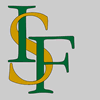 Index Fungorum: ID=
Index Fungorum: ID= Encyclopedia of Life (EOL): Search
Encyclopedia of Life (EOL): Search - CNALH: Search
- NatureServe:
 ODBaL Search
ODBaL SearchNucleotide Search
Chaenotheca balsamconensis J. L. Allen & McMullin
ID=227
Type(s):
Synonyms:
Habit and Morphology: Lichenized with a trebouxioid (Chlorococcales) alga. Immersed, with aggregations of hyphae and algae visible with compound microscopy. Reddish brown pigments may be present and react K+ red. Stalk 1 - 1.5 mm tall, thin, black. Capitulum obconical to obovate, typically < 0.5 mm wide.
Anatomy: Excipulum well developed. Asci catenulate, forming chains. Ascospores spherical, smooth, 3-6 ?m diameter.
Chemistry: Stalk typically K+ magenta. Thallus UV+ orange (unknown xanthone) and sometimes with reddish-brown spots that are K+ red.
Habitat: Reported as growing only on the bracket fungus Tricaptum abietinum. Calicioids are known to jump between substrates from one climatic region to another (e.g. wood vs bark, angiosperm vs conifer) so I would regard host specificity to be rather tenuous.
Biogeography: Known only from eastern North America.
Global Rank:
Conservation: This species was described very recently, but was speculated to be increasing in abundance due to increases in forest pathogens.
Notes: The formal description of this species compared it with C. ferruginea, and to a lesser degree with C. trichialis. However, the description seems closely allied to C. brunneola, C. hygrophila, and C. sphaerocephala.
External Information:
ID=227
Type(s):
Synonyms:
Habit and Morphology: Lichenized with a trebouxioid (Chlorococcales) alga. Immersed, with aggregations of hyphae and algae visible with compound microscopy. Reddish brown pigments may be present and react K+ red. Stalk 1 - 1.5 mm tall, thin, black. Capitulum obconical to obovate, typically < 0.5 mm wide.
Anatomy: Excipulum well developed. Asci catenulate, forming chains. Ascospores spherical, smooth, 3-6 ?m diameter.
Chemistry: Stalk typically K+ magenta. Thallus UV+ orange (unknown xanthone) and sometimes with reddish-brown spots that are K+ red.
Habitat: Reported as growing only on the bracket fungus Tricaptum abietinum. Calicioids are known to jump between substrates from one climatic region to another (e.g. wood vs bark, angiosperm vs conifer) so I would regard host specificity to be rather tenuous.
Biogeography: Known only from eastern North America.
Global Rank:
Conservation: This species was described very recently, but was speculated to be increasing in abundance due to increases in forest pathogens.
Notes: The formal description of this species compared it with C. ferruginea, and to a lesser degree with C. trichialis. However, the description seems closely allied to C. brunneola, C. hygrophila, and C. sphaerocephala.
External Information:
 Index Fungorum: ID=811647
Index Fungorum: ID=811647 Encyclopedia of Life (EOL): Search
Encyclopedia of Life (EOL): Search - CNALH: Species Record
- NatureServe:
 ODBaL Search
ODBaL SearchNucleotide Search
Chaenotheca biesboschii Tibell & van der Pluijm
ID=245
Type(s):
Synonyms:
Habit and Morphology:
Anatomy:
Chemistry:
Habitat:
Biogeography:
Global Rank:
Conservation:
Notes:
External Information:
ID=245
Type(s):
Synonyms:
Habit and Morphology:
Anatomy:
Chemistry:
Habitat:
Biogeography:
Global Rank:
Conservation:
Notes:
External Information:
 Index Fungorum: ID=
Index Fungorum: ID= Encyclopedia of Life (EOL): Search
Encyclopedia of Life (EOL): Search - CNALH: Search
- NatureServe:
 ODBaL Search
ODBaL SearchNucleotide Search
Chaenotheca brachypoda (Ach.) Tibell
ID=38
Type(s):
Synonyms:
Habit and Morphology:
Anatomy:
Chemistry:
Habitat:
Biogeography:
Global Rank:
Conservation:
Notes:
External Information:
ID=38
Type(s):
Synonyms:
Habit and Morphology:
Anatomy:
Chemistry:
Habitat:
Biogeography:
Global Rank:
Conservation:
Notes:
External Information:
 Index Fungorum: ID=
Index Fungorum: ID= Encyclopedia of Life (EOL): Search
Encyclopedia of Life (EOL): Search - CNALH: Search
- NatureServe:
 ODBaL Search
ODBaL SearchNucleotide Search
Chaenotheca brunneola (Ach.) Müll. Arg.
ID=39
Type(s):
Synonyms:
Habit and Morphology:
Anatomy:
Chemistry:
Habitat:
Biogeography:
Global Rank:
Conservation:
Notes:
External Information:
ID=39
Type(s):
Synonyms:
Habit and Morphology:
Anatomy:
Chemistry:
Habitat:
Biogeography:
Global Rank:
Conservation:
Notes:
External Information:
 Index Fungorum: ID=
Index Fungorum: ID= Encyclopedia of Life (EOL): Search
Encyclopedia of Life (EOL): Search - CNALH: Search
- NatureServe:
 ODBaL Search
ODBaL SearchNucleotide Search
Chaenotheca chlorella (Ach.) M?ll. Arg.
ID=40
Type(s):
Synonyms:
Habit and Morphology:
Anatomy:
Chemistry:
Habitat:
Biogeography:
Global Rank:
Conservation:
Notes:
External Information:
ID=40
Type(s):
Synonyms:
Habit and Morphology:
Anatomy:
Chemistry:
Habitat:
Biogeography:
Global Rank:
Conservation:
Notes:
External Information:
 Index Fungorum: ID=
Index Fungorum: ID= Encyclopedia of Life (EOL): Search
Encyclopedia of Life (EOL): Search - CNALH: Search
- NatureServe:
 ODBaL Search
ODBaL SearchNucleotide Search
Chaenotheca chloroxantha Tibell
ID=228
Type(s):
Synonyms:
Habit and Morphology:
Anatomy:
Chemistry:
Habitat:
Biogeography:
Global Rank:
Conservation:
Notes: Mentioned in Aptroot and Tibell (2003) and both Mycobank and Index Fungorum have records, but those records do not provide references or dates. The Recend Literature on Lichens database lacks any records for this.
External Information:
ID=228
Type(s):
Synonyms:
Habit and Morphology:
Anatomy:
Chemistry:
Habitat:
Biogeography:
Global Rank:
Conservation:
Notes: Mentioned in Aptroot and Tibell (2003) and both Mycobank and Index Fungorum have records, but those records do not provide references or dates. The Recend Literature on Lichens database lacks any records for this.
External Information:
 Index Fungorum: ID=475286
Index Fungorum: ID=475286 Encyclopedia of Life (EOL): Search
Encyclopedia of Life (EOL): Search - CNALH: Search
- NatureServe:
 ODBaL Search
ODBaL SearchNucleotide Search
Chaenotheca chrysocephala (Turner ex Ach.) Th. Fr.
ID=41
Type(s):
Synonyms:
Habit and Morphology:
Anatomy:
Chemistry:
Habitat:
Biogeography:
Global Rank:
Conservation:
Notes:
External Information:
ID=41
Type(s):
Synonyms:
Habit and Morphology:
Anatomy:
Chemistry:
Habitat:
Biogeography:
Global Rank:
Conservation:
Notes:
External Information:
 Index Fungorum: ID=
Index Fungorum: ID= Encyclopedia of Life (EOL): Search
Encyclopedia of Life (EOL): Search - CNALH: Search
- NatureServe:
 ODBaL Search
ODBaL SearchNucleotide Search
Chaenotheca cinerea (Pers.) Tibell
ID=42
Type(s):
Synonyms:
Habit and Morphology:
Anatomy:
Chemistry:
Habitat:
Biogeography:
Global Rank:
Conservation:
Notes:
External Information:
ID=42
Type(s):
Synonyms:
Habit and Morphology:
Anatomy:
Chemistry:
Habitat:
Biogeography:
Global Rank:
Conservation:
Notes:
External Information:
 Index Fungorum: ID=
Index Fungorum: ID= Encyclopedia of Life (EOL): Search
Encyclopedia of Life (EOL): Search - CNALH: Search
- NatureServe:
 ODBaL Search
ODBaL SearchNucleotide Search
Chaenotheca citriocephala (F. Wilson) Tibell
ID=43
Type(s):
Synonyms:
Habit and Morphology:
Anatomy:
Chemistry:
Habitat:
Biogeography:
Global Rank:
Conservation:
Notes:
External Information:
ID=43
Type(s):
Synonyms:
Habit and Morphology:
Anatomy:
Chemistry:
Habitat:
Biogeography:
Global Rank:
Conservation:
Notes:
External Information:
 Index Fungorum: ID=
Index Fungorum: ID= Encyclopedia of Life (EOL): Search
Encyclopedia of Life (EOL): Search - CNALH: Search
- NatureServe:
 ODBaL Search
ODBaL SearchNucleotide Search
Chaenotheca confusa Tibell
ID=44
Type(s):
Synonyms:
Habit and Morphology:
Anatomy:
Chemistry:
Habitat:
Biogeography:
Global Rank:
Conservation:
Notes:
External Information:
ID=44
Type(s):
Synonyms:
5071:
Habit and Morphology:
Anatomy:
Chemistry:
Habitat:
Biogeography:
Global Rank:
Conservation:
Notes:
External Information:
 Index Fungorum: ID=
Index Fungorum: ID= Encyclopedia of Life (EOL): Search
Encyclopedia of Life (EOL): Search - CNALH: Search
- NatureServe:
 ODBaL Search
ODBaL SearchNucleotide Search
Chaenotheca deludens Tibell
ID=45
Type(s):
Synonyms:
Habit and Morphology:
Anatomy:
Chemistry:
Habitat:
Biogeography:
Global Rank:
Conservation:
Notes:
External Information:
ID=45
Type(s):
Synonyms:
Habit and Morphology:
Anatomy:
Chemistry:
Habitat:
Biogeography:
Global Rank:
Conservation:
Notes:
External Information:
 Index Fungorum: ID=
Index Fungorum: ID= Encyclopedia of Life (EOL): Search
Encyclopedia of Life (EOL): Search - CNALH: Search
- NatureServe:
 ODBaL Search
ODBaL SearchNucleotide Search
Chaenotheca ferruginea (Turner ex Ach.) Mig.
ID=46
Type(s):
Synonyms:
Habit and Morphology:
Anatomy:
Chemistry:
Habitat:
Biogeography:
Global Rank:
Conservation:
Notes:
External Information:
ID=46
Type(s):
Synonyms:
Habit and Morphology:
Anatomy:
Chemistry:
Habitat:
Biogeography:
Global Rank:
Conservation:
Notes:
External Information:
 Index Fungorum: ID=
Index Fungorum: ID= Encyclopedia of Life (EOL): Search
Encyclopedia of Life (EOL): Search - CNALH: Search
- NatureServe:
 ODBaL Search
ODBaL SearchNucleotide Search
Chaenotheca floridana R. C. Harris
ID=47
Type(s):
Synonyms:
Habit and Morphology:
Anatomy:
Chemistry:
Habitat:
Biogeography:
Global Rank:
Conservation:
Notes:
External Information:
ID=47
Type(s):
Synonyms:
Habit and Morphology:
Anatomy:
Chemistry:
Habitat:
Biogeography:
Global Rank:
Conservation:
Notes:
External Information:
 Index Fungorum: ID=
Index Fungorum: ID= Encyclopedia of Life (EOL): Search
Encyclopedia of Life (EOL): Search - CNALH: Search
- NatureServe:
 ODBaL Search
ODBaL SearchNucleotide Search
Chaenotheca furfuracea (L.) Tibell
ID=48
Type(s):
Synonyms:
Habit and Morphology:
Anatomy:
Chemistry:
Habitat:
Biogeography:
Global Rank:
Conservation:
Notes:
External Information:
ID=48
Type(s):
Synonyms:
Habit and Morphology:
Anatomy:
Chemistry:
Habitat:
Biogeography:
Global Rank:
Conservation:
Notes:
External Information:
 Index Fungorum: ID=
Index Fungorum: ID= Encyclopedia of Life (EOL): Search
Encyclopedia of Life (EOL): Search - CNALH: Search
- NatureServe:
 ODBaL Search
ODBaL SearchNucleotide Search
Chaenotheca gracilenta (Ach.) Mattsson & Middelb.
ID=49
Type(s):
Synonyms:
Habit and Morphology:
Anatomy:
Chemistry:
Habitat:
Biogeography:
Global Rank:
Conservation:
Notes:
External Information:
ID=49
Type(s):
Synonyms:
Habit and Morphology:
Anatomy:
Chemistry:
Habitat:
Biogeography:
Global Rank:
Conservation:
Notes:
External Information:
 Index Fungorum: ID=
Index Fungorum: ID= Encyclopedia of Life (EOL): Search
Encyclopedia of Life (EOL): Search - CNALH: Search
- NatureServe:
 ODBaL Search
ODBaL SearchNucleotide Search
Chaenotheca gracillima (Vainio) Tibell
ID=50
Type(s):
Synonyms:
Habit and Morphology:
Anatomy:
Chemistry:
Habitat:
Biogeography:
Global Rank:
Conservation:
Notes:
External Information:
ID=50
Type(s):
Synonyms:
Habit and Morphology:
Anatomy:
Chemistry:
Habitat:
Biogeography:
Global Rank:
Conservation:
Notes:
External Information:
 Index Fungorum: ID=
Index Fungorum: ID= Encyclopedia of Life (EOL): Search
Encyclopedia of Life (EOL): Search - CNALH: Search
- NatureServe:
 ODBaL Search
ODBaL SearchNucleotide Search
Chaenotheca hispidula (Ach.) Zahlbr.
ID=51
Type(s):
Synonyms:
Habit and Morphology:
Anatomy:
Chemistry:
Habitat:
Biogeography:
Global Rank:
Conservation:
Notes:
External Information:
ID=51
Type(s):
Synonyms:
Habit and Morphology:
Anatomy:
Chemistry:
Habitat:
Biogeography:
Global Rank:
Conservation:
Notes:
External Information:
 Index Fungorum: ID=
Index Fungorum: ID= Encyclopedia of Life (EOL): Search
Encyclopedia of Life (EOL): Search - CNALH: Search
- NatureServe:
 ODBaL Search
ODBaL SearchNucleotide Search
Chaenotheca hygrophila Tibell
ID=52
Type(s):
Synonyms:
Habit and Morphology:
Anatomy:
Chemistry:
Habitat:
Biogeography:
Global Rank:
Conservation:
Notes:
External Information:
ID=52
Type(s):
Synonyms:
Habit and Morphology:
Anatomy:
Chemistry:
Habitat:
Biogeography:
Global Rank:
Conservation:
Notes:
External Information:
 Index Fungorum: ID=
Index Fungorum: ID= Encyclopedia of Life (EOL): Search
Encyclopedia of Life (EOL): Search - CNALH: Search
- NatureServe:
 ODBaL Search
ODBaL SearchNucleotide Search
Chaenotheca laevigata N?dv.
ID=53
Type(s):
Synonyms:
Habit and Morphology:
Anatomy:
Chemistry:
Habitat:
Biogeography:
Global Rank:
Conservation:
Notes:
External Information:
ID=53
Type(s):
Synonyms:
Habit and Morphology:
Anatomy:
Chemistry:
Habitat:
Biogeography:
Global Rank:
Conservation:
Notes:
External Information:
 Index Fungorum: ID=
Index Fungorum: ID= Encyclopedia of Life (EOL): Search
Encyclopedia of Life (EOL): Search - CNALH: Search
- NatureServe:
 ODBaL Search
ODBaL SearchNucleotide Search
Chaenotheca longispora Reese Næsborg & Tibell
ID=230
Type(s):
Synonyms:
Habit and Morphology: Chlorococcales, Trebouxioid. Superficial, greenish to yellowish grey, granular to leprose. Medium height (ca. 1 mm), black stalk and excipulum with a yellow pruina primarily on the excipulum.
Anatomy: Single asci formed on hyphal stalks. Ascospores elipsoidal to cylindrical, 12.1-18.6 (-25.0) ?m in length, at maturity becoming well pigmented, deeply cracked with a spiral ornamentation, and often multiseptate.
Chemistry: K+ yellow, C-, KC-, PD+ orange, UV- (either fumarprotocetraric or succinoprotocetraric acid)
Habitat: Conifer bark (Sequoia sempervirens)
Biogeography: Described thus far only from redwood canopies along California's central coast. However, I suspect that I've seen specimens from Oregon and Washington that were previously squeezed into a broad concept of Chaenotheca laevigata; a photo of the spores from one is included here, but lacks specific measurements for validation.
Global Rank:
Conservation:
Notes:
External Information:
ID=230
Type(s):
Synonyms:
Habit and Morphology: Chlorococcales, Trebouxioid. Superficial, greenish to yellowish grey, granular to leprose. Medium height (ca. 1 mm), black stalk and excipulum with a yellow pruina primarily on the excipulum.
Anatomy: Single asci formed on hyphal stalks. Ascospores elipsoidal to cylindrical, 12.1-18.6 (-25.0) ?m in length, at maturity becoming well pigmented, deeply cracked with a spiral ornamentation, and often multiseptate.
Chemistry: K+ yellow, C-, KC-, PD+ orange, UV- (either fumarprotocetraric or succinoprotocetraric acid)
Habitat: Conifer bark (Sequoia sempervirens)
Biogeography: Described thus far only from redwood canopies along California's central coast. However, I suspect that I've seen specimens from Oregon and Washington that were previously squeezed into a broad concept of Chaenotheca laevigata; a photo of the spores from one is included here, but lacks specific measurements for validation.
Global Rank:
Conservation:
Notes:
External Information:
 Index Fungorum: ID=
Index Fungorum: ID= Encyclopedia of Life (EOL): Search
Encyclopedia of Life (EOL): Search - CNALH: Search
- NatureServe:
 ODBaL Search
ODBaL SearchNucleotide Search
Chaenotheca nitidula Tibell
ID=54
Type(s): Tibell & Koffman 2002
Synonyms:
Habit and Morphology:
Anatomy:
Chemistry:
Habitat:
Biogeography:
Global Rank:
Conservation:
Notes:
External Information:
ID=54
Type(s): Tibell & Koffman 2002
Synonyms:
Habit and Morphology:
Anatomy:
Chemistry:
Habitat:
Biogeography:
Global Rank:
Conservation:
Notes:
External Information:
 Index Fungorum: ID=
Index Fungorum: ID= Encyclopedia of Life (EOL): Search
Encyclopedia of Life (EOL): Search - CNALH: Search
- NatureServe:
 ODBaL Search
ODBaL SearchNucleotide Search
Chaenotheca olivaceorufa Vainio
ID=55
Type(s):
Synonyms:
Habit and Morphology:
Anatomy:
Chemistry:
Habitat:
Biogeography:
Global Rank:
Conservation:
Notes:
External Information:
ID=55
Type(s):
Synonyms:
Chaenotheca degelii Tibell (See Tibell 1996)
Habit and Morphology:
Anatomy:
Chemistry:
Habitat:
Biogeography:
Global Rank:
Conservation:
Notes:
External Information:
 Index Fungorum: ID=
Index Fungorum: ID= Encyclopedia of Life (EOL): Search
Encyclopedia of Life (EOL): Search - CNALH: Search
- NatureServe:
 ODBaL Search
ODBaL SearchNucleotide Search
Chaenotheca papuensis Aptroot & Tibell
ID=56
Type(s): See Aptroot & Tibell 2003
Synonyms:
Habit and Morphology: Photobiont trebouxioid. Superficial, gray, verrucose. 0.7 - 1 mm tall, covered with yellow pruina. Excipulum described as pooly developed, yet sufficient to form a cup at the base of the capitulum.
Anatomy: Single, stalked. Spherical to slightly elipsoidal, 3.5-4.5 um, with an ornamentation of irregular cracks.
Chemistry: Thallus K+ yellow, C-, KC-, P+ yellow.
Habitat: Described from wooden huts at about 2000 m altitude. Lignum.
Biogeography: Known only from Papua New Guinea.
Global Rank:
Conservation:
Notes: I would like to see the type specimen for this species. The formal description lacks photographs of anatomical characteristis and is styled a little differently from much of Tibell's works, making it a little difficult to compare. The description mentions similarity to C. chlorella, from which it differs in photobiont, spore ornamentation, and thallus chemistry. It is also mentioned as similar to C. chloroxantha, differing by ascomatal stature, spore size, and thallus chemistry.
External Information:
ID=56
Type(s): See Aptroot & Tibell 2003
Synonyms:
Habit and Morphology: Photobiont trebouxioid. Superficial, gray, verrucose. 0.7 - 1 mm tall, covered with yellow pruina. Excipulum described as pooly developed, yet sufficient to form a cup at the base of the capitulum.
Anatomy: Single, stalked. Spherical to slightly elipsoidal, 3.5-4.5 um, with an ornamentation of irregular cracks.
Chemistry: Thallus K+ yellow, C-, KC-, P+ yellow.
Habitat: Described from wooden huts at about 2000 m altitude. Lignum.
Biogeography: Known only from Papua New Guinea.
Global Rank:
Conservation:
Notes: I would like to see the type specimen for this species. The formal description lacks photographs of anatomical characteristis and is styled a little differently from much of Tibell's works, making it a little difficult to compare. The description mentions similarity to C. chlorella, from which it differs in photobiont, spore ornamentation, and thallus chemistry. It is also mentioned as similar to C. chloroxantha, differing by ascomatal stature, spore size, and thallus chemistry.
External Information:
 Index Fungorum: ID=
Index Fungorum: ID= Encyclopedia of Life (EOL): Search
Encyclopedia of Life (EOL): Search - CNALH: Search
- NatureServe:
 ODBaL Search
ODBaL SearchNucleotide Search
Chaenotheca phaeocephala (Turner) Th. Fr.
ID=57
Type(s):
Synonyms:
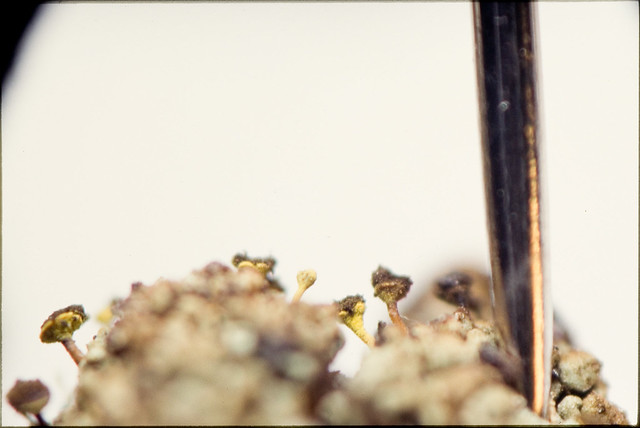
Habit and Morphology:
Anatomy:
Chemistry:
Habitat:
Biogeography:
Global Rank:
Conservation:
Notes:
External Information:
ID=57
Type(s):
Synonyms:
Unspecified collections:

Chaenotheca phaeocephala
This form with short/stout stalks and a well developed thallus is typical in Europe, but this may be the only specimen of this form known from the Pacific Northwest where it is typically much more slender and with a less developed thallus. The odd form could be due to the location by watered lawns on OSU campus. On Quercus, March 1998; EBP#2390. Photographed with color transparency film at approximately 5x magnification.
Habit and Morphology:
Anatomy:
Chemistry:
Habitat:
Biogeography:
Global Rank:
Conservation:
Notes:
External Information:
 Index Fungorum: ID=
Index Fungorum: ID= Encyclopedia of Life (EOL): Search
Encyclopedia of Life (EOL): Search - CNALH: Search
- NatureServe:
 ODBaL Search
ODBaL SearchNucleotide Search
Chaenotheca servitii N?dv.
ID=58
Type(s):
Synonyms:
Habit and Morphology:
Anatomy:
Chemistry:
Habitat:
Biogeography:
Global Rank:
Conservation:
Notes:
External Information:
ID=58
Type(s):
Synonyms:
Habit and Morphology:
Anatomy:
Chemistry:
Habitat:
Biogeography:
Global Rank:
Conservation:
Notes:
External Information:
 Index Fungorum: ID=
Index Fungorum: ID= Encyclopedia of Life (EOL): Search
Encyclopedia of Life (EOL): Search - CNALH: Search
- NatureServe:
 ODBaL Search
ODBaL SearchNucleotide Search
Chaenotheca sp. nov. 1
ID=231
Type(s):
Synonyms:
Habit and Morphology: Chlorococcales. Whitish, granular. Short, thick (<1 mm), scruffy looking with what is probably disintegrating hyphae on the excipulum, but can appear like a thin whitish pruina (with perhaps just a hint of yellowish).
Anatomy: Spherical, 3-5 ?m, moderately rough ornamentation.
Chemistry:
Habitat: Conifer bark.
Biogeography: Washington
Global Rank:
Conservation:
Notes:
External Information:
ID=231
Type(s):
Synonyms:
Habit and Morphology: Chlorococcales. Whitish, granular. Short, thick (<1 mm), scruffy looking with what is probably disintegrating hyphae on the excipulum, but can appear like a thin whitish pruina (with perhaps just a hint of yellowish).
Anatomy: Spherical, 3-5 ?m, moderately rough ornamentation.
Chemistry:
Habitat: Conifer bark.
Biogeography: Washington
Global Rank:
Conservation:
Notes:
External Information:
 Index Fungorum: ID=
Index Fungorum: ID= Encyclopedia of Life (EOL): Search
Encyclopedia of Life (EOL): Search - CNALH: Search
- NatureServe:
 ODBaL Search
ODBaL SearchNucleotide Search
Chaenotheca sphaerocephala N?dv.
ID=59
Type(s):
Synonyms:
Habit and Morphology:
Anatomy:
Chemistry:
Habitat:
Biogeography:
Global Rank:
Conservation:
Notes:
External Information:
ID=59
Type(s):
Synonyms:
Habit and Morphology:
Anatomy:
Chemistry:
Habitat:
Biogeography:
Global Rank:
Conservation:
Notes:
External Information:
 Index Fungorum: ID=
Index Fungorum: ID= Encyclopedia of Life (EOL): Search
Encyclopedia of Life (EOL): Search - CNALH: Search
- NatureServe:
 ODBaL Search
ODBaL SearchNucleotide Search
Chaenotheca stemonea (Ach.) M?ll. Arg.
ID=60
Type(s):
Synonyms:
Habit and Morphology:
Anatomy:
Chemistry:
Habitat:
Biogeography:
Global Rank:
Conservation:
Notes:
External Information:
ID=60
Type(s):
Synonyms:
Habit and Morphology:
Anatomy:
Chemistry:
Habitat:
Biogeography:
Global Rank:
Conservation:
Notes:
External Information:
 Index Fungorum: ID=
Index Fungorum: ID= Encyclopedia of Life (EOL): Search
Encyclopedia of Life (EOL): Search - CNALH: Search
- NatureServe:
 ODBaL Search
ODBaL SearchNucleotide Search
Chaenotheca subroscida (Eitner) Zahlbr.
ID=61
Type(s):
Synonyms:
Habit and Morphology:
Anatomy:
Chemistry:
Habitat:
Biogeography:
Global Rank:
Conservation:
Notes:
External Information:
ID=61
Type(s):
Synonyms:
Habit and Morphology:
Anatomy:
Chemistry:
Habitat:
Biogeography:
Global Rank:
Conservation:
Notes:
External Information:
 Index Fungorum: ID=
Index Fungorum: ID= Encyclopedia of Life (EOL): Search
Encyclopedia of Life (EOL): Search - CNALH: Search
- NatureServe:
 ODBaL Search
ODBaL SearchNucleotide Search
Chaenotheca trichialis (Ach.) Th. Fr.
ID=62
Type(s):
Synonyms:
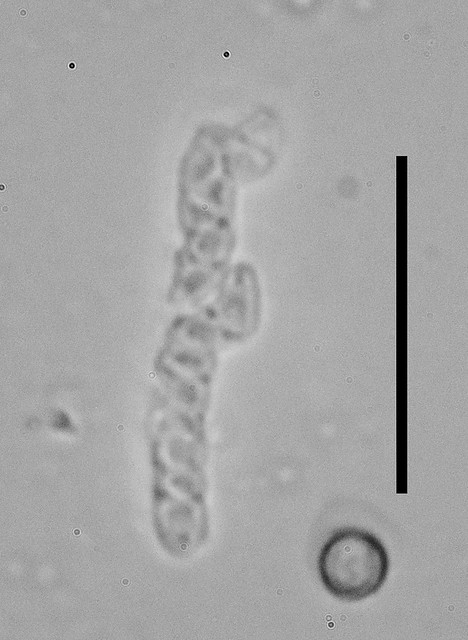
Habit and Morphology:
Anatomy:
Chemistry:
Habitat:
Biogeography:
Global Rank:
Conservation:
Notes:
External Information:
ID=62
Type(s):
Synonyms:
Unspecified collections:

Catenulate asci of Chaenotheca trichialis
Two asci together in a chain with crosiers (the bump to the side).
Habit and Morphology:
Anatomy:
Chemistry:
Habitat:
Biogeography:
Global Rank:
Conservation:
Notes:
External Information:
 Index Fungorum: ID=
Index Fungorum: ID= Encyclopedia of Life (EOL): Search
Encyclopedia of Life (EOL): Search - CNALH: Search
- NatureServe:
 ODBaL Search
ODBaL SearchNucleotide Search
Chaenotheca xyloxena N?dv.
ID=63
Type(s):
Synonyms:
Habit and Morphology:
Anatomy:
Chemistry:
Habitat:
Biogeography:
Global Rank:
Conservation:
Notes:
External Information:
ID=63
Type(s):
Synonyms:
Habit and Morphology:
Anatomy:
Chemistry:
Habitat:
Biogeography:
Global Rank:
Conservation:
Notes:
External Information:
 Index Fungorum: ID=
Index Fungorum: ID= Encyclopedia of Life (EOL): Search
Encyclopedia of Life (EOL): Search - CNALH: Search
- NatureServe:
 ODBaL Search
ODBaL SearchNucleotide Search
Count of taxa = 32
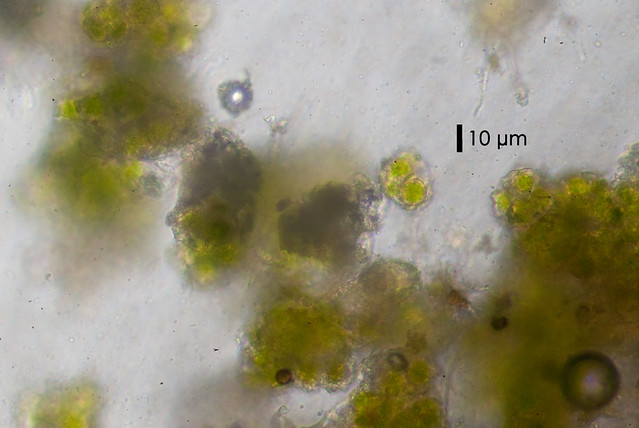
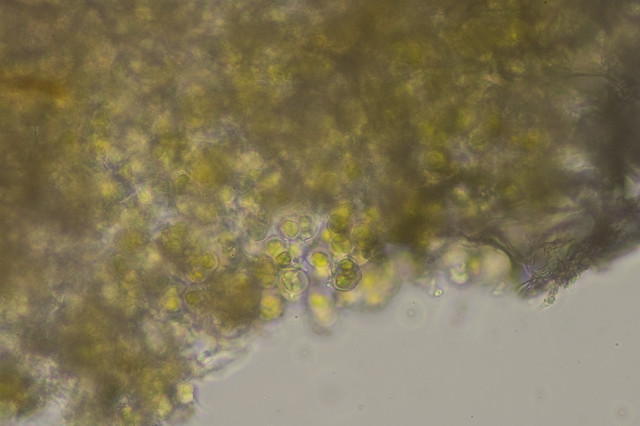
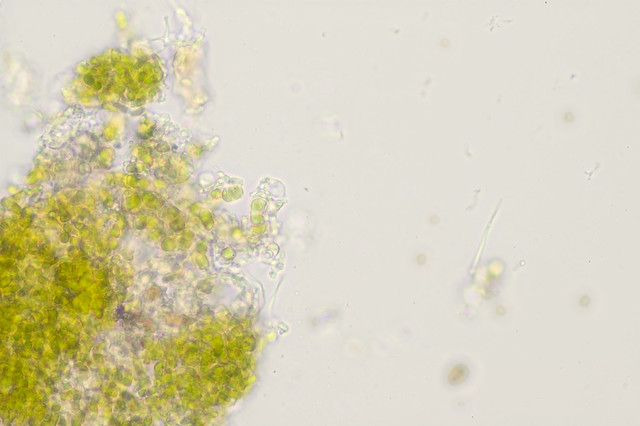
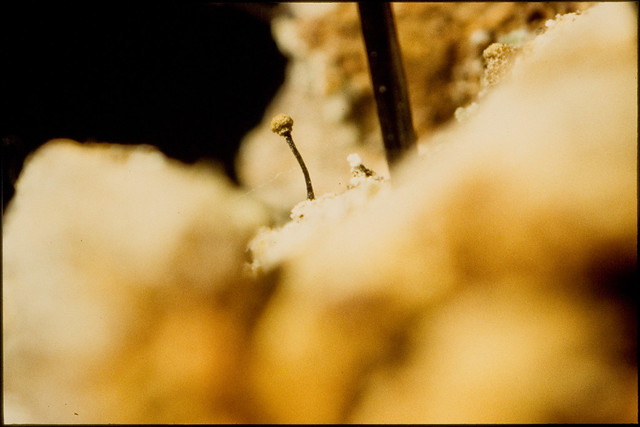
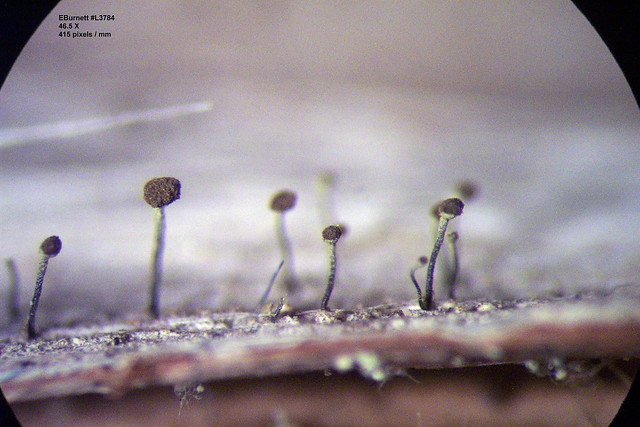
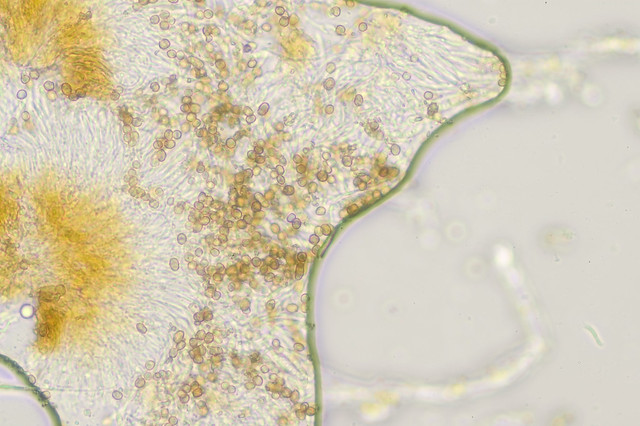
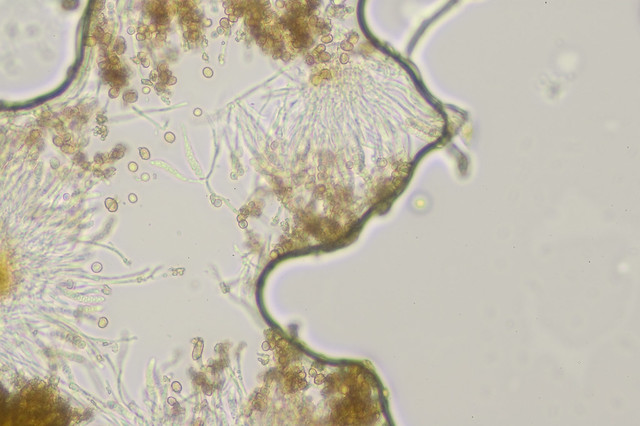
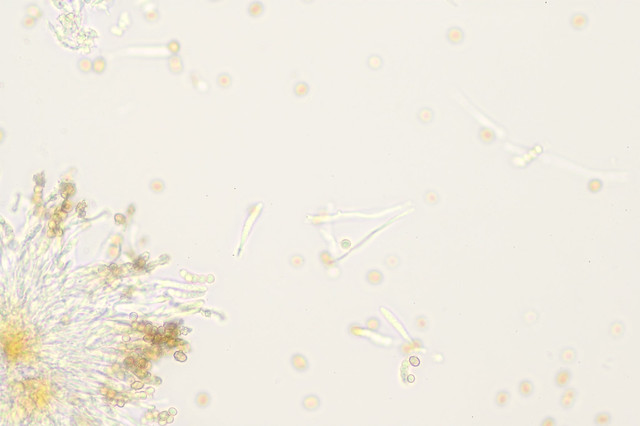
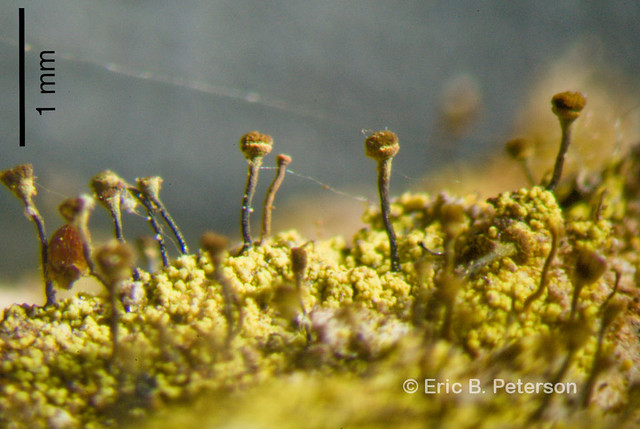
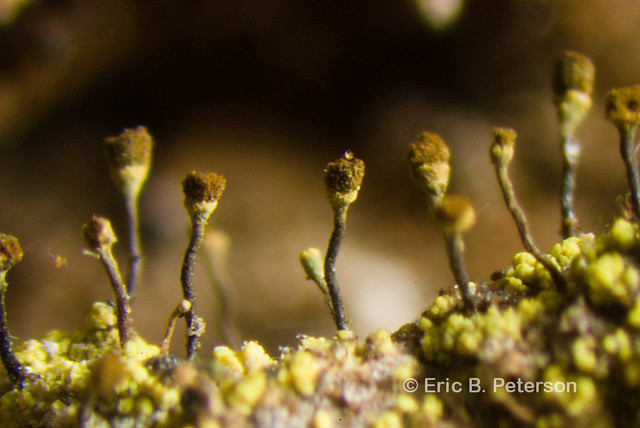
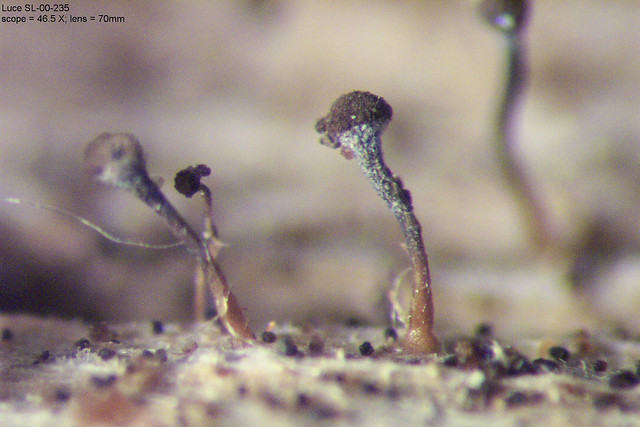
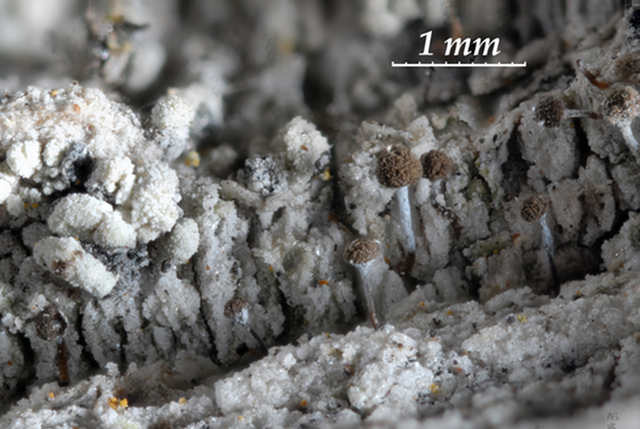
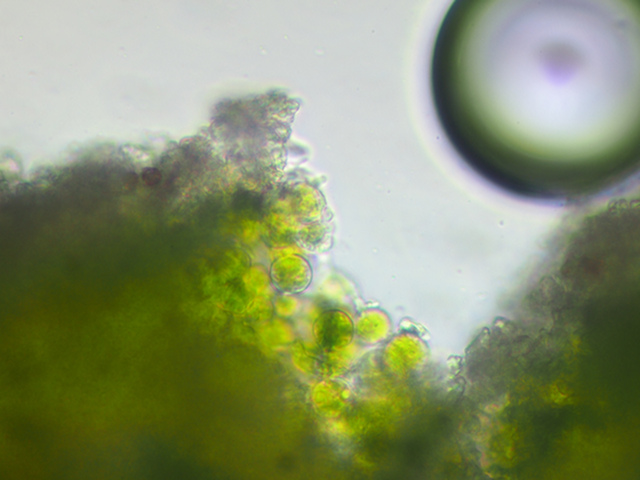
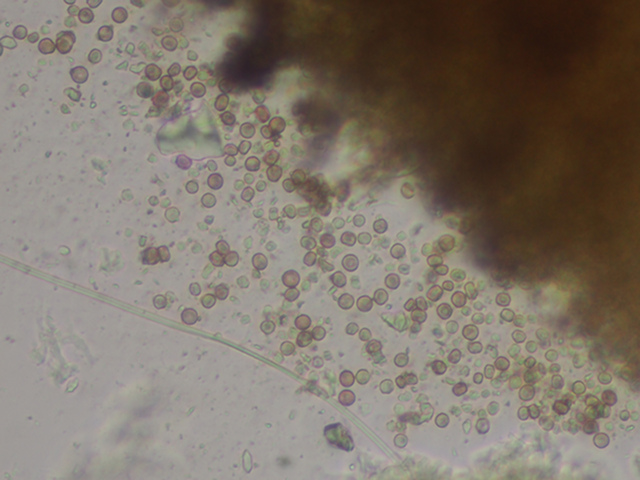

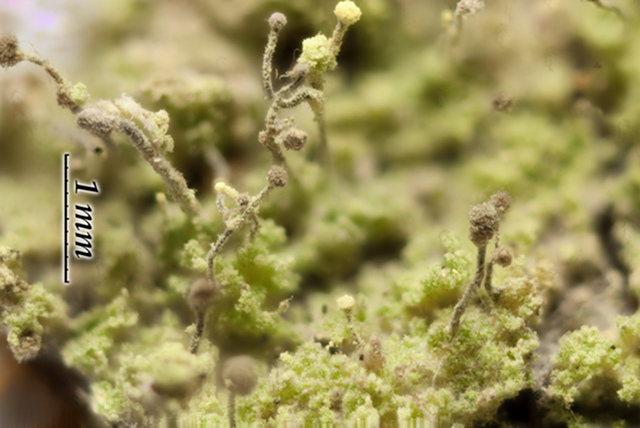
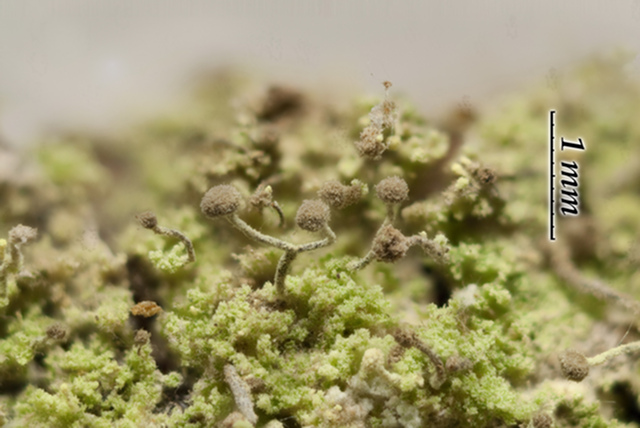
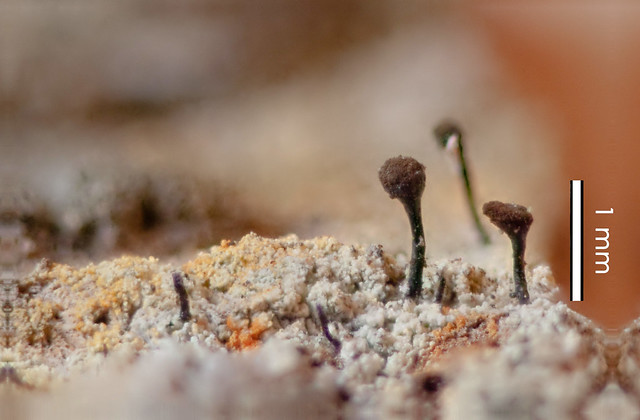
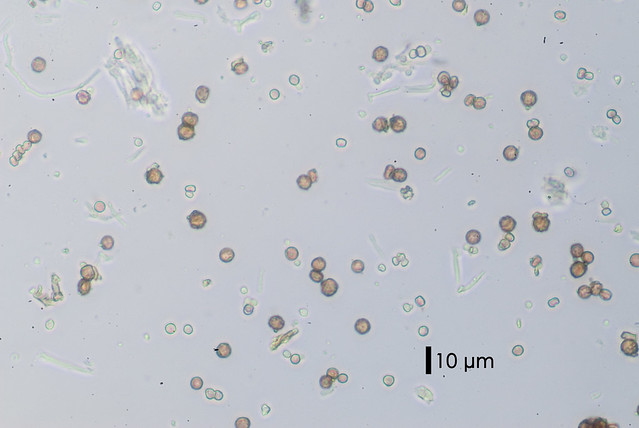
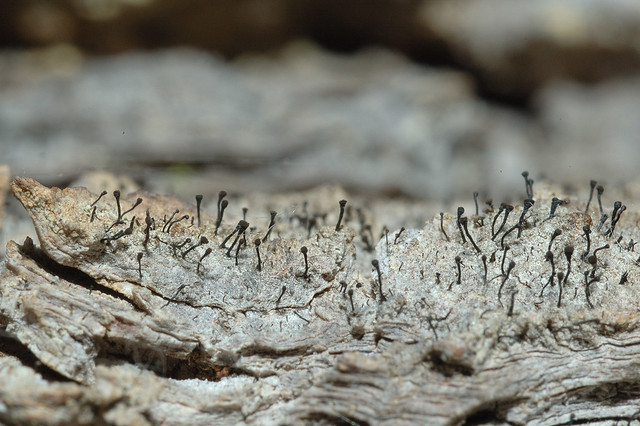
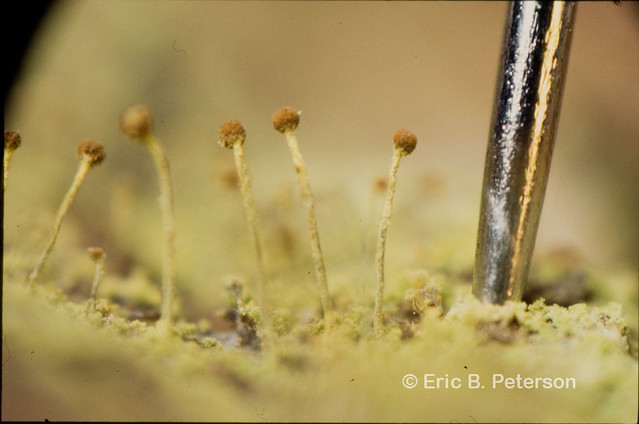



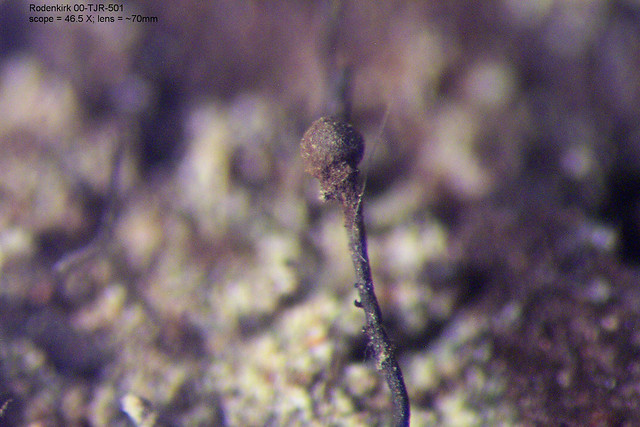
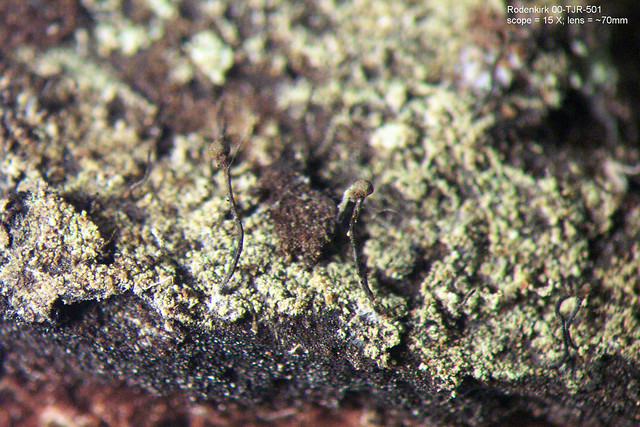
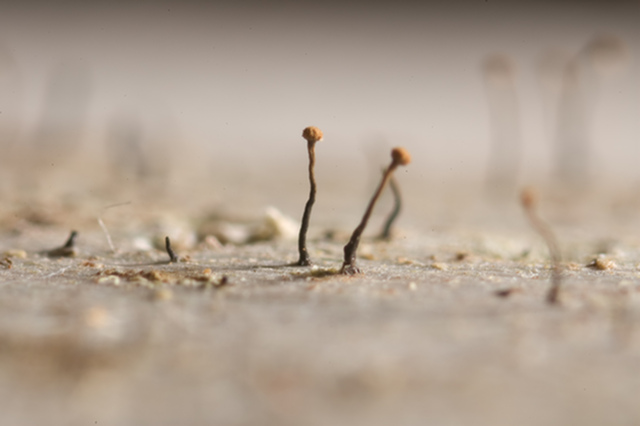
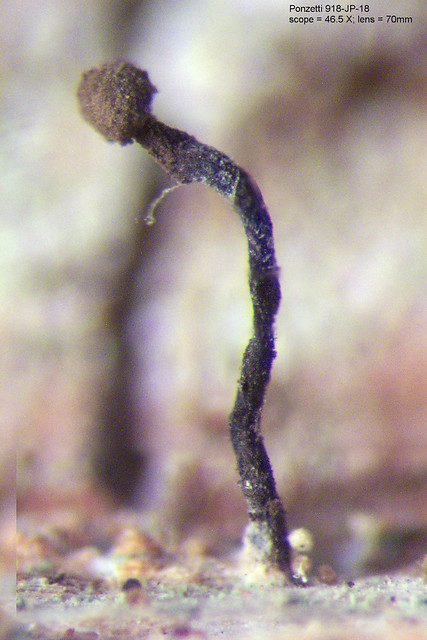
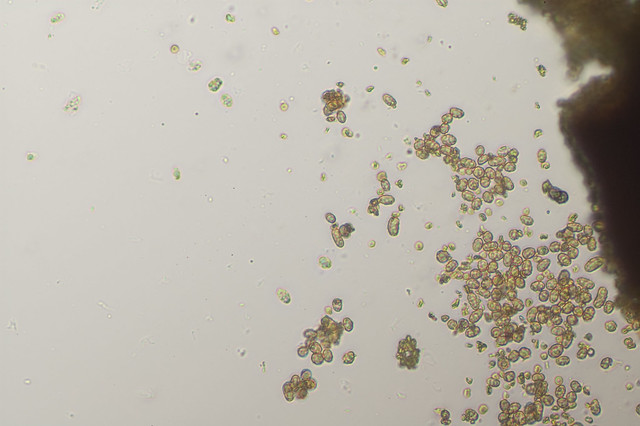

 2-2-Edit_640px.jpg)
-2-Edit_640px.jpg)
